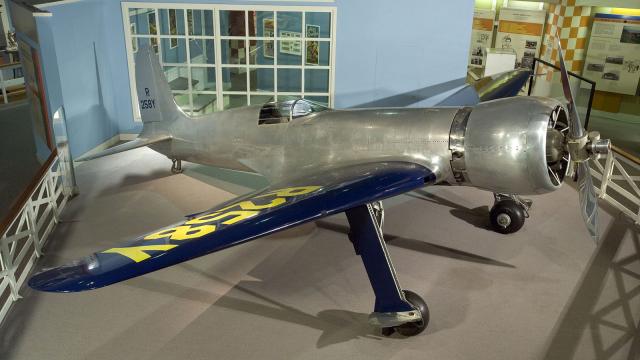Inspired by the fleet of aircraft featured in his film Hell’s Angels, Howard Hughes did what any business magnate/aviation engineer/super rich guy would — he designed and built a plane fast enough to break the transcontinental landplane speed record. And in doing so, he catapulted aviation technology leagues beyond the bi-plane of the day.
Hughes began drafting the plane’s design in 1934 with the help of Richard Palmer, a Cal Tech graduate already famous for his radical aircraft design, and hired Glenn Odekirk, who had supervised the Hell’s Angels fleet, to oversee the planes construction.
Dubbed the H-1 — or simply the Racer, as Hughes preferred — this one-of-a-kind plane measured 8m nose to tail and stood 2.4m tall with a 10m wingspan. Its single Pratt & Whitney R-1535 radial engine was originally rated at 700hp, but when fully tuned put out a whopping 1000hp at its 2590m cruising altitude.
The H-1 fuselage was a sight to behold as well, covered in its polished aluminium skin. The H-1 also employed custom-machined rivets that held the skin perfectly flush to the plane’s frame, as well as retractable landing gear, in order to reduce drag.
In September, 1935 the H-1 took off from a Southern California airfield with Hughes himself at the controls. Four passes over a carefully monitored course later and Hughes set down owning a new world landspeed record at an average of 567km/h. Hughes flew the plane so hard he ran out of fuel before he could land and had to crash the H-1 into a beet field. He walked away from the crash, reportedly only saying, “We can fix her, she’ll go faster.”
With the overall speed record under his belt, Hughes set his sites on the transcontinental speed record, set in 1932 by Jim Haizlip in just under 10.5 hours. For this nonstop cross-country flight, Hughes outfitted the H-1 with longer wings to lessen the stress each would endure over the 4007km flight. On January 19, 1937, the H-1 departed Los Angeles bound for Newark with Hughes again at the controls. Just 7 hours, 28 minutes, and 25 seconds later, he set the H-1 down on the East Coast — a full three hours faster than Haizlip and nearly as quickly as modern airliners do.
“It was the last non-military plane to set a world speed record,” Jim Wright, told the Smithsonian. Wright built a near-exact full-size replica of the H-1 in 2002. “It was also the last time an individual could design an aeroplane that was world-class. After this, planes of this calibre were designed by teams of hundreds or thousands of people. The Hughes Racer was a personal statement. And when you work on a machine designed by an individual, you learn a lot about that person. The Racer turned out to be a very mysterious aeroplane. But then, Howard was a very mysterious person.”
Although Hughes was unsuccessful in his bid to sell the Racer design to the US military prior to World War II, the H-1 proved the worth of radial engine-powered planes and inspired future aircraft such as the F6F Hellcat, P-47 Thunderbolt, and even, according to Hughes, the infamous Japanese Mitsubishi Type 0.
The H-1 didn’t see much air time after its historic flight and in 1975 was donated to the Smithsonian. It now rests in the National Air and Space Museum in Washington, DC. [Smithsonian Institute – Wiki – Air & Space Magazine – Boeing]
